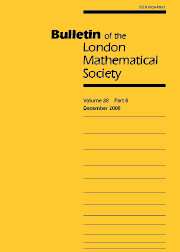Article contents
ALAN BREACH TAYLER
Published online by Cambridge University Press: 01 July 1998
Abstract
Alan Breach Tayler, CBE, Director of the Oxford Centre for Industrial and Applied Mathematics, died on 28 January 1995, aged 63.
Alan went up to Oxford in 1951 to read Mathematics at Brasenose College. He obtained a first, and after a brief excursion to the Bristol Aircraft Company, he returned to work for a DPhil with George Temple. His thesis, completed in 1959 and entitled ‘Problems in compressible flow’, contained a mixture of analytic, approximate and numerical solutions which foreshadowed the new practical applied mathematics that he embraced later. He became University Lecturer and Tutorial Fellow of St Catherine's Society in 1959.
During the next twenty-five years, Alan Tayler brought a new ethos to applied mathematics. This change came about through his recognition that the status quo in the 1960s, which comprised a delicate balance between theory and practice in the area of applied mechanics, was capable of far-reaching generalisation; indeed, he saw that such a development was essential since the following decades were to be dominated by computers and an ever-increasing need for mathematical modelling. In 1967, with Leslie Fox, he initiated the mathematical Study Groups with Industry, wherein academic and industrial researchers interact in week-long workshops. These were an immediate success: (1) with industry, who found new insights into their problems and new recruiting possibilities; (2) with students, whose enthusiasm to use their theoretical knowledge soon led to the highly popular MSc in Mathematical Modelling and Numerical Analysis; and (3) with faculty, both pure and applied, who found an undreamed of source of fascinating new theoretical problems. For example, one intellectual consequence was the use of industrial case studies to uncover the new field of ‘free boundary problems’, on which several thousand learned articles have appeared since 1970.
- Type
- Obituary
- Information
- Copyright
- © The London Mathematical Society 1998
- 2
- Cited by


